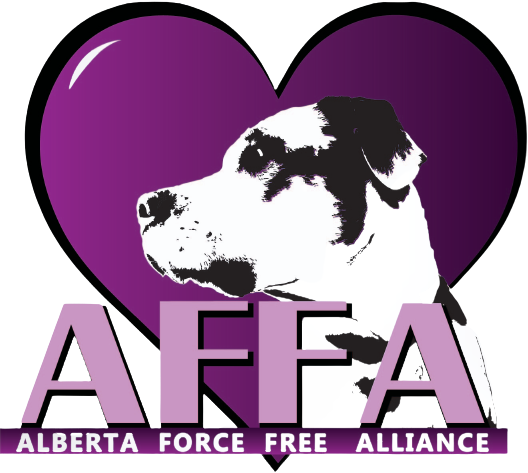Welcome!The Alberta Force Free Alliance provides a one-stop resource for pet owners who want to ensure that all of their animals are trained, cared for, and handled in a loving and force-free manner. Whether it is at training classes, veterinary services, grooming, doggy daycare, breeders, kennels, boarding, animal events, or retailers. Everyone listed in the AFFA Directory have signed a pledge promising that the dogs entrusted to their care or under their instruction are handled without intentional intimidation, flooding (full force of negative stimuli), force, or pain. That the dog should be handled with as little restraint as is safe for the dog, staff, and humans involved and without intent to cause harm. The retailers listed will not sell or promote any training accessories or equipment that will intentionally cause fear and pain to the dog. These products include; citronella collars, ultrasonic bark deterrents, pet correctors, choke collars, prong collars, or shock/bark/electronic collars. |
WHO WE ARE We are a volunteer-run, Alberta-based organization dedicated to promoting the use of Force-Free methods with animals. | WHAT WE DO We provide a business directory for pet owners committed to finding Force-Free care for their pets, as well as educational opportunities for animal professionals and members of the public. | WHY WE DO IT Thousands of hours of hands-on experience and decades of scientific research have brought us here. Force-Free training methods are a humane, effective choice that anyone can learn! |
MYTHS AND MISUNDERSTANDINGS |
Myth: All dogs learn differently and need different training methods.RealityWhile it’s true that dogs differ in their natural skills and preferences, all organisms share one important thing: they learn (change their behaviour) in two basic ways. Learning by Consequences (Operant Conditioning)From single-celled organisms to humans, we all change our actions in order to get the results that benefit us most, or hurt us the least. We learn to stop by the reception desk to get a candy, or to be careful on ice after we slip and hurt ourselves. We go to work because we get paid, which allows us to get the things we need to survive. When something works, we do it more, and when it doesn’t work, we try something new. This is operant conditioning. Without this process, animals don’t survive, so it’s hard-wired into all of them. Learning by Association (Classical Conditioning)When two events consistently occur close together, we start to anticipate the second event, and often make a choice about what to do based on that anticipation. This process is classical conditioning, and is often occurring without us realizing it. We smell dinner cooking and come to the kitchen to get some. We pick up the dog’s leash and take them for a walk, and before long they’re beating us to the door at the first sign of the leash. We pick up the nail clippers to trim the dog’s nails, and soon they’re disappearing as soon as they see you searching for them. Classical conditioning creates strong, involuntary responses that affect an animal’s behaviour. | Myth: My dog isn't food motivated, so I can't use positive reinforcement.RealityAny animal that needs to eat to live is food motivated, although the level of motivation may change depending on the situation. There are also many other options available for positive reinforcement! Why won’t my dog take food in training?Even though all dogs are food motivated, this motivation increases and decreases throughout the day based on when they last ate, and may not be enough to outweigh their interest in some distractions. You can make food a more useful part of your training by using your dog’s meals to reward them, training when they are hungry, and getting more distance from their distractions. What can we use to reward our dogs?Anything that our dogs are willing to work to get can be used as positive reinforcement. This can be anything from food, to play, to affection, to a walk, to chasing rabbits, and beyond! Consider making a list of all the things your dog enjoys most and ranking it in order of what they would put the most effort into getting. Think about how that list might change in different situations. |
